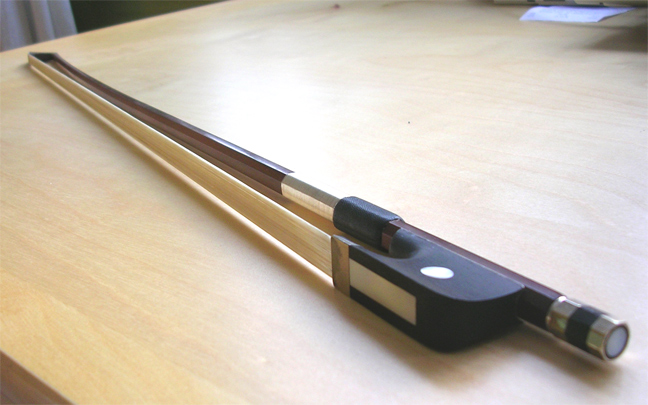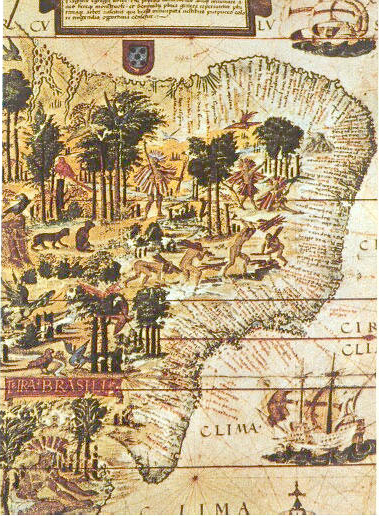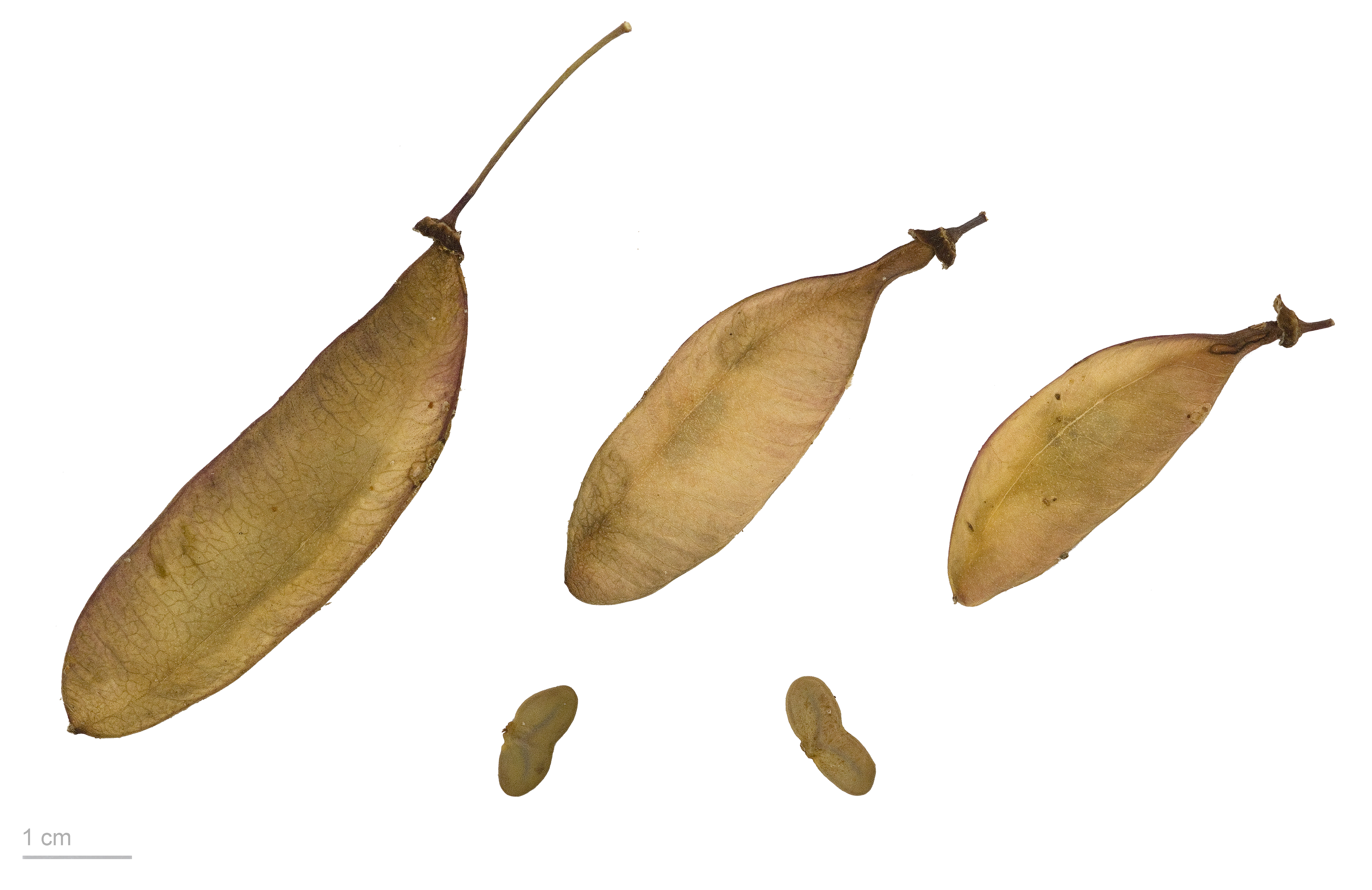|
Brazilwood
''Paubrasilia echinata'' is a species of flowering plant in the legume family, Fabaceae, that is endemic to the Atlantic Forest of Brazil. It is a Brazilian timber tree commonly known as Pernambuco wood or brazilwood ( pt, pau-de-pernambuco, ; Tupi: ) and is the national tree of Brazil. This plant has a dense, orange-red heartwood that takes a high shine, and it is the premier wood used for making bows for stringed instruments. The wood also yields a historically important red dye called brazilin, which oxidizes to brazilein. The name ''pau-brasil'' was applied to certain species of the genus ''Caesalpinia'' in the medieval period, and was given its original scientific name ''Caesalpinia echinata'' in 1785 by Jean-Baptiste Lamarck. More recent taxonomic studies have suggested that it merits recognition as a separate genus, and it was thus renamed ''Paubrasilia echinata'' in 2016. The Latin specific epithet of ''echinata'' refers to hedgehog, from ''echinus'', and describes t ... [...More Info...] [...Related Items...] OR: [Wikipedia] [Google] [Baidu] |
Name Of Brazil
The name ''Brazil'' is a shortened form of ''Terra do Brasil'' ("Land of Brazil"), a reference to the brazilwood tree. The name was given in the early 16th century to the territories leased to the merchant consortium led by Fernão de Loronha, to exploit brazilwood for the production of wood dyes for the European textile industry. The term for the brazilwood tree in Portuguese, ''pau-brasil'', is formed by ''pau'' ("wood") and '' brasa'' ("ember"), the latter referring to the vivid red dye that can be extracted from the tree. The word ''brasa'' is formed from Old French ''brese'' ("ember, glowing charcoal"). Native names According to tradition, before colonisation, the native name of the land was the one given by the local indigenous peoples, '' Pindorama'' ( Tupi for "Land of the Palms"). However, exact translation of "Land of Palms" would be ''Pindotetama'' or ''Pindoretama'' in the Tupi language, suggesting ''Pindorama'' may be a later corruption of the original term. ''Pi ... [...More Info...] [...Related Items...] OR: [Wikipedia] [Google] [Baidu] |
Brazil
Brazil ( pt, Brasil; ), officially the Federative Republic of Brazil (Portuguese: ), is the largest country in both South America and Latin America. At and with over 217 million people, Brazil is the world's fifth-largest country by area and the seventh most populous. Its capital is Brasília, and its most populous city is São Paulo. The federation is composed of the union of the 26 States of Brazil, states and the Federal District (Brazil), Federal District. It is the largest country to have Portuguese language, Portuguese as an List of territorial entities where Portuguese is an official language, official language and the only one in the Americas; one of the most Multiculturalism, multicultural and ethnically diverse nations, due to over a century of mass Immigration to Brazil, immigration from around the world; and the most populous Catholic Church by country, Roman Catholic-majority country. Bounded by the Atlantic Ocean on the east, Brazil has a Coastline of Brazi ... [...More Info...] [...Related Items...] OR: [Wikipedia] [Google] [Baidu] |
Brazilin
Brazilin is a naturally occurring red dye obtained from the wood of ''Paubrasilia echinata'', ''Caesalpinia sappan'', ''Caesalpinia violacea'', and ''Haematoxylum brasiletto'' (also known as Natural Red 24 and CI 75280). Brazilin has been used since at least the Middle Ages to natural dye, dye fabric, and has been used to make paints and inks as well. The specific color produced by the pigment depends on its manner of preparation: in an acidic solution brazilin will appear yellow, but in an alkaline preparation it will appear red. Brazilin is closely related to the blue-black dye precursor haematoxylin, hematoxylin, having one fewer hydroxyl group. Brazilein, the active dye agent, is an oxidized form of brazilin. Sources of brazilin Brazilin is obtained from the wood of ''Paubrasilia echinata'', ''Caesalpinia sappan'' (Sappanwood), ''Caesalpinia violacea'', and ''Haematoxylum brasiletto''. The sappanwood is found in India, Malaysia, Indonesia and Sri Lanka, the latter being a ma ... [...More Info...] [...Related Items...] OR: [Wikipedia] [Google] [Baidu] |
Pernambuco
Pernambuco () is a state of Brazil, located in the Northeast region of the country. With an estimated population of 9.6 million people as of 2020, making it seventh-most populous state of Brazil and with around 98,148 km², being the 19th-largest in area among federative units of the country, it is the sixth-most densely populated with around 89 people per km². Its capital and largest city, Recife, is one of the most important economic and urban hubs in the country. Based on 2019 estimates, the Recife Metropolitan Region is seventh-most populous in the country, and the second-largest in northeastern Brazil. In 2015, the state had 4.6% of the national population and produced 2.8% of the national gross domestic product (GDP). The contemporary state inherits its name from the Captaincy of Pernambuco, established in 1534. The region was originally inhabited by Tupi-Guarani-speaking peoples. European colonization began in the 16th century, under mostly Portuguese rule in ... [...More Info...] [...Related Items...] OR: [Wikipedia] [Google] [Baidu] |
Caesalpinia Sappan
''Biancaea sappan'' is a species of flowering tree in the legume family, Fabaceae, that is native to tropical Asia. Common names in English include sappanwood and Indian redwood. Sappanwood is related to brazilwood (''Paubrasilia echinata''), and was originally called "brezel wood" in Europe. Biencaea sappan can be infected by twig dieback (''Lasiodiplodia theobromae''). This plant has many uses. It has antibacterial and anticoagulant properties. It also produces a valuable reddish dye called brazilin, used for dyeing fabric as well as making red paints and inks. Slivers of heartwood are used for making herbal drinking water in various regions, such as Kerala, Karnataka and Central Java, where it is usually mixed with ginger, cinnamon, and cloves. The heartwood also contains juglone (5-hydroxy-1,4-naphthoquinone), which has antimicrobial activity. Homoisoflavonoids (sappanol, episappanol, 3'-deoxysappanol, 3'-O-methylsappanol, 3'-O-methylepisappanol and sappanone A) can ... [...More Info...] [...Related Items...] OR: [Wikipedia] [Google] [Baidu] |
Sappanwood
''Biancaea sappan'' is a species of flowering tree in the legume family, Fabaceae, that is native to tropical Asia. Common names in English include sappanwood and Indian redwood. Sappanwood is related to brazilwood (''Paubrasilia echinata''), and was originally called "brezel wood" in Europe. Biencaea sappan can be infected by twig dieback (''Lasiodiplodia theobromae''). This plant has many uses. It has antibacterial and anticoagulant properties. It also produces a valuable reddish dye called brazilin, used for dyeing fabric as well as making red paints and inks. Slivers of heartwood are used for making herbal drinking water in various regions, such as Kerala, Karnataka and Central Java, where it is usually mixed with ginger, cinnamon, and cloves. The heartwood also contains juglone (5-hydroxy-1,4-naphthoquinone), which has antimicrobial activity. Homoisoflavonoids (sappanol, episappanol, 3'-deoxysappanol, 3'-O-methylsappanol, 3'-O-methylepisappanol and sappanone A) can also be ... [...More Info...] [...Related Items...] OR: [Wikipedia] [Google] [Baidu] |
Rosids
The rosids are members of a large clade (monophyletic group) of flowering plants, containing about 70,000 species, more than a quarter of all angiosperms. The clade is divided into 16 to 20 orders, depending upon circumscription and classification. These orders, in turn, together comprise about 140 families. Fossil rosids are known from the Cretaceous period. Molecular clock estimates indicate that the rosids originated in the Aptian or Albian stages of the Cretaceous, between 125 and 99.6 million years ago. Today's forests are highly dominated by rosid species, which in turn helped with diversification in many other living lineages. Additionally, rosid herbs and shrubs are also a significant part of arctic/alpine, temperate floras, aquatics, desert plants, and parasites. Name The name is based upon the name "Rosidae", which had usually been understood to be a subclass. In 1967, Armen Takhtajan showed that the correct basis for the name "Rosidae" is a description of a group of ... [...More Info...] [...Related Items...] OR: [Wikipedia] [Google] [Baidu] |
Eudicots
The eudicots, Eudicotidae, or eudicotyledons are a clade of flowering plants mainly characterized by having two seed leaves upon germination. The term derives from Dicotyledons. Traditionally they were called tricolpates or non-magnoliid dicots by previous authors. The botanical terms were introduced in 1991 by evolutionary botanist James A. Doyle and paleobotanist Carol L. Hotton to emphasize the later evolutionary divergence of tricolpate dicots from earlier, less specialized, dicots. Numerous familiar plants are eudicots, including many common food plants, trees, and ornamentals. Some common and familiar eudicots include sunflower, dandelion, forget-me-not, cabbage, apple, buttercup, maple, and macadamia. Most leafy trees of midlatitudes also belong to eudicots, with notable exceptions being magnolias and tulip trees which belong to magnoliids, and ''Ginkgo biloba'', which is not an angiosperm. Description The close relationships among flowering plants with tricolpat ... [...More Info...] [...Related Items...] OR: [Wikipedia] [Google] [Baidu] |
Haematoxylum Brasiletto
''Haematoxylum brasiletto'', or Mexican logwood, is a species of tropical hardwood tree in the legume family, Fabaceae. It is known in its native Mexico and Guatemala as "palo de brasil" or "palo de tinto". The timber is used to make bows for stringed instruments, the manufacture of dyes and in ethnobotany. Description ''H. brasiletto'' is a small tree or large thorny shrub, seven to fifteen metres high. The trunk and larger branches are fluted and the heartwood is deep red. The tree has pinnate leaves with three pairs of heart-shaped leaflets and no terminal leaflet. The clusters of yellow flowers are typical of the Caesalpinioideae, with five distinct lobes, and are followed by copper-coloured seed pods that split laterally when ripe, rather than at the edge. The seeds are black and kidney-shaped.Logwood and Brazilw ... [...More Info...] [...Related Items...] OR: [Wikipedia] [Google] [Baidu] |
Legume
A legume () is a plant in the family Fabaceae (or Leguminosae), or the fruit or seed of such a plant. When used as a dry grain, the seed is also called a pulse. Legumes are grown agriculturally, primarily for human consumption, for livestock forage and silage, and as soil-enhancing green manure. Well-known legumes include beans, soybeans, chickpeas, peanuts, lentils, lupins, mesquite, carob, tamarind, alfalfa, and clover. Legumes produce a botanically unique type of fruit – a simple dry fruit that develops from a simple carpel and usually dehisces (opens along a seam) on two sides. Legumes are notable in that most of them have symbiotic nitrogen-fixing bacteria in structures called root nodules. For that reason, they play a key role in crop rotation. Terminology The term ''pulse'', as used by the United Nations' Food and Agriculture Organization (FAO), is reserved for legume crops harvested solely for the dry seed. This excludes green beans and green peas, which a ... [...More Info...] [...Related Items...] OR: [Wikipedia] [Google] [Baidu] |
Kingdom Of Portugal
The Kingdom of Portugal ( la, Regnum Portugalliae, pt, Reino de Portugal) was a monarchy in the western Iberian Peninsula and the predecessor of the modern Portuguese Republic. Existing to various extents between 1139 and 1910, it was also known as the Kingdom of Portugal and the Algarves after 1415, and as the United Kingdom of Portugal, Brazil and the Algarves between 1815 and 1822. The name is also often applied to the Portuguese Empire, the realm's overseas colonies. The nucleus of the Portuguese state was the County of Portugal, established in the 9th century as part of the ''Reconquista'', by Vímara Peres, a vassal of the King of Asturias. The county became part of the Kingdom of León in 1097, and the Counts of Portugal established themselves as rulers of an independent kingdom in the 12th century, following the battle of São Mamede. The kingdom was ruled by the Alfonsine Dynasty until the 1383–85 Crisis, after which the monarchy passed to the House of Aviz. Dur ... [...More Info...] [...Related Items...] OR: [Wikipedia] [Google] [Baidu] |
Angiosperms
Flowering plants are plants that bear flowers and fruits, and form the clade Angiospermae (), commonly called angiosperms. The term "angiosperm" is derived from the Greek words ('container, vessel') and ('seed'), and refers to those plants that produce their seeds enclosed within a fruit. They are by far the most diverse group of land plants with 64 orders, 416 families, approximately 13,000 known genera and 300,000 known species. Angiosperms were formerly called Magnoliophyta (). Like gymnosperms, angiosperms are seed-producing plants. They are distinguished from gymnosperms by characteristics including flowers, endosperm within their seeds, and the production of fruits that contain the seeds. The ancestors of flowering plants diverged from the common ancestor of all living gymnosperms before the end of the Carboniferous, over 300 million years ago. The closest fossil relatives of flowering plants are uncertain and contentious. The earliest angiosperm fossils are in the ... [...More Info...] [...Related Items...] OR: [Wikipedia] [Google] [Baidu] |





